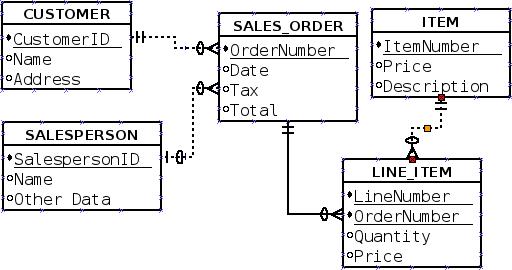More Patterns
- Line-Item Pattern
- Consider a company where customers place orders
- A customer places an order
- The customer may go through a sales person, or not.
- An order has many different items. (Called line items in this context)
- Four simple entities
- Customer
- Sales Person
- Order
- Item
- But like may other examples an additional entity is needed.
- Is a line item (item no, quantity, price, extended price) part of any of these entities?
- Probably not, so a line item entity is created.
-

- Notice LINE_ITEM <-> SALES_ORDER is weak, (Identifying).
- Nothing very special here in implementation.
- SalesOrderNumber will be part of a primary key in LINE_ITEM
- ItemNumber will be a foreign key in the LINE_ITEM table.
- It may not be null.
- This does lead to a discussion (Eventually) of what happens if an order is deleted.
- Or if an item is deleted from an order.
- Just a side note on other tables
- SALES_ORDER will have foreign keys:
- CustomerID which must be not NULL, WHY?
- SalespersonID, which may be NULL, WHY?
- Several other examples of this pattern are given.
- For Use By Pattern
- This pattern occurs when polymorphism is required.
- Look at table 5-36 on page 182
- This pattern is named after the "For Use By" fields.
- Notice in this case, there are two of them.
- This is the same as having special cases for graduate/undergraduate students.
- This is a subtype in an ER-Diagram.
- A subtype is indicated by a circle.
- If the circle has an X, the type is exclusive (only one case)
- Graduate/Undergraduate
- If the circle does not have an X, it is inclusive, student in multiple clubs.

- We will be using two different tables for the subtypes.
- We will need to add a field tot he FISHING_LICENSE (IsCommercial) to indicate which table to search for data in.
- We will use FICHING_LICENSE.LicenseNumber as a primary key in each of the subtypes.
- He states that there is no way to make sure that a license number is not used in both tables in relational databases. The font end logic needs to make sure of this.
- Recursive Patterns
- 1:1
- The example is using a DB to store information about a train.
- Specifically we want to maintain the order of the cars.
- So an engine has a relationship with 0 or 1 engines.
- An engine has a relationship with 0 or 1 cars
- A car has a relationship with 0 or 1 cars.
-

- In each case, place the relating id into the table and mark it unique, but nullable.
- 1:N recursive
- An employee manages other employees.
- A field in the employee field contains manager id.
- N:M recursive
- Many parts build a wagon.
- The handle is built of many parts


